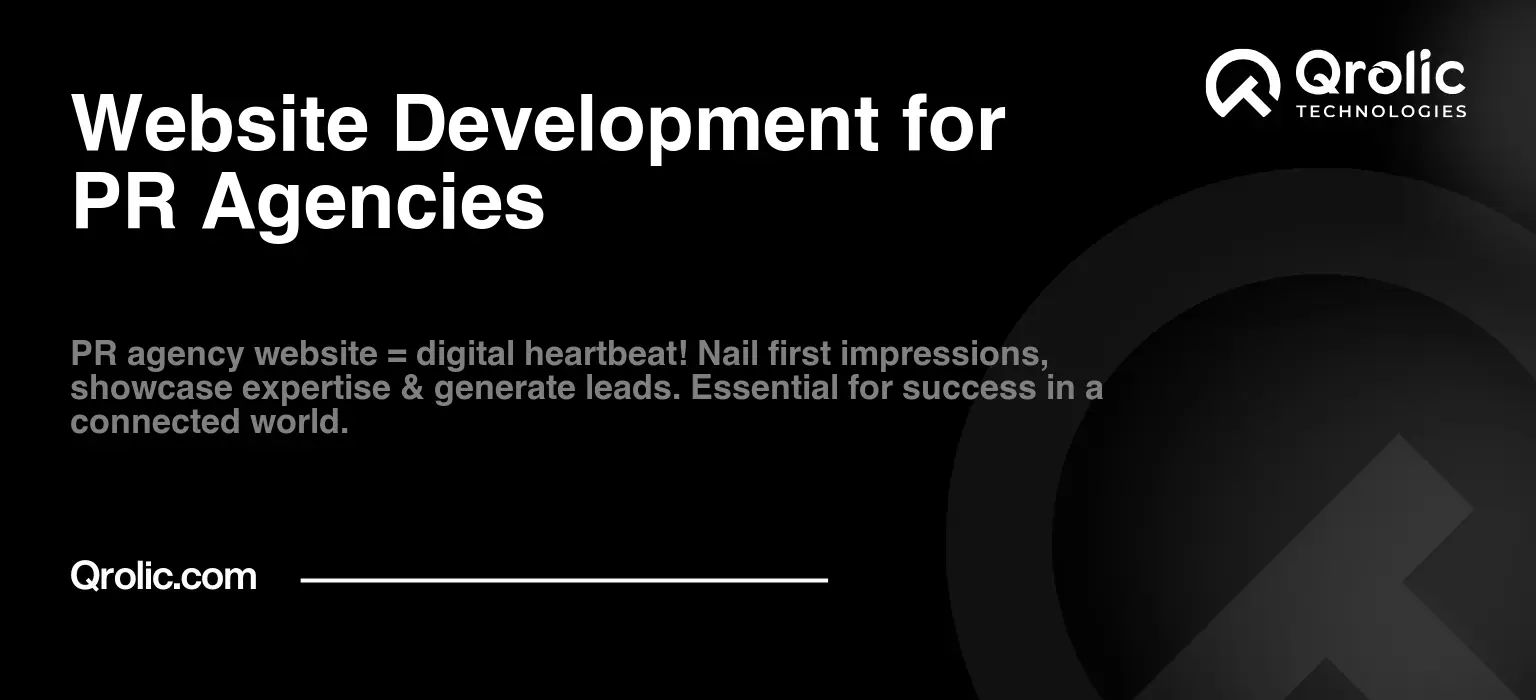Quick Summary:
- A strong website is vital for PR agency success and credibility.
- Plan carefully with clear goals, great design, and valuable content.
- Ensure technical performance, strong SEO, and ongoing security.
- Embrace future trends like AI and accessibility to stay relevant.
Table of Contents
- The Indispensable Digital Face: Why PR Agencies Need Stellar Websites
- Why a Great Website Matters More Than Ever
- The Cost of a Bad Website: Missed Opportunities
- Laying the Foundation: Essential Elements of a Winning PR Agency Website
- 1. Defining Your Target Audience: Know Your Client
- 2. Setting Clear Goals: What Do You Want Your Website to Achieve?
- 3. Information Architecture: Structuring Your Content for Success
- 4. Content Strategy: Fueling Your Website with Value
- Designing for Impact: Visual Appeal and User Experience in PR Web Design
- 1. Visual Branding: Reflecting Your Agency’s Identity
- 2. User-Friendly Navigation: Guiding Visitors Seamlessly
- 3. Calls to Action (CTAs): Driving Conversions
- 4. Mobile Responsiveness: Adapting to Every Screen
- Technical Mastery: Development and Optimization for Peak Performance
- 1. Choosing the Right Platform: CMS Selection (WordPress, Drupal, etc.)
- 2. Optimizing for Speed: Page Load Time is Critical
- 3. Implementing SEO Best Practices: Making Your Website Discoverable
- 4. Security Measures: Protecting Your Website and Data
- Content is King (and Queen!): Creating Engaging and Valuable Content
- 1. Blog Posts: Sharing Insights and Expertise
- 2. Case Studies: Demonstrating Your Successes
- 3. Videos: Engaging Your Audience Visually
- 4. Infographics: Visualizing Data and Information
- The Power of a Portfolio: Showcasing Your Best Work
- 1. Highlighting Successful Campaigns: Showcasing Your Achievements
- 2. Organizing Your Portfolio: Making it Easy to Browse
- 3. Maintaining an Up-to-Date Portfolio: Keeping it Fresh and Relevant
- Measuring Success: Analytics and Reporting
- 1. Setting Up Google Analytics: Tracking Key Metrics
- 2. Analyzing Data and Identifying Areas for Improvement
- 3. Reporting and Communication: Sharing Insights with Your Team
- Ongoing Maintenance: Keeping Your Website Fresh and Secure
- 1. Regular Updates: CMS, Plugins, and Themes
- 2. Security Monitoring: Protecting Against Threats
- 3. Content Refresh: Keeping Your Content Relevant
- 4. Performance Optimization: Ensuring Speed and Reliability
- Qrolic Technologies: Your Partner in PR Agency Website Development
- Why Choose Qrolic Technologies?
- Our Services
- Let’s Discuss Your Project
- Future Trends: What’s Next for PR Agency Websites?
- 1. Artificial Intelligence (AI) and Chatbots: Enhancing User Experience
- 2. Voice Search Optimization: Adapting to How People Search
- 3. Interactive Content: Engaging Visitors in New Ways
- 4. Accessibility: Ensuring Your Website is Usable by Everyone
The Indispensable Digital Face: Why PR Agencies Need Stellar Websites
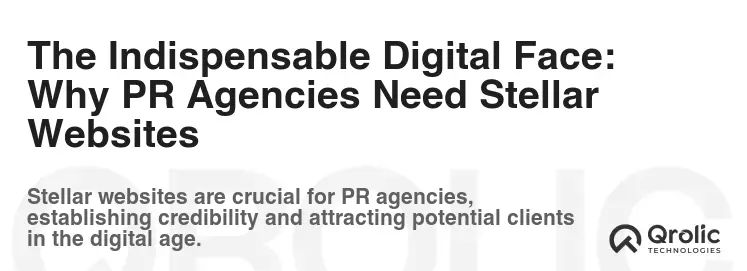
In today’s hyper-connected world, a public relations (PR) agency’s website isn’t just an online brochure; it’s the digital heartbeat of their brand, their portfolio, and their outreach. It’s the first (and often the only) impression many potential clients will have. A poorly designed or outdated website screams “incompetent” louder than any press release ever could. This is why PR agency website development is paramount to success.
Why a Great Website Matters More Than Ever
- First Impressions are Everything: Potential clients are judging you within seconds. A visually appealing, professionally designed website establishes credibility instantly.
- Showcasing Expertise: Your website is your opportunity to demonstrate your industry knowledge, successful campaigns, and unique approach to PR.
- Generating Leads: A well-optimized website acts as a lead generation machine, attracting potential clients through relevant content and clear calls to action.
- Building Brand Authority: Consistent branding, thought leadership content (blog posts, articles, case studies), and client testimonials solidify your agency’s position as an industry leader.
- Attracting Talent: A compelling website attracts top talent looking for a dynamic and innovative workplace.
- 24/7 Availability: Unlike traditional marketing efforts, your website is working for you around the clock, providing information and engaging potential clients at any time.
The Cost of a Bad Website: Missed Opportunities
Conversely, a poorly designed website can be disastrous:
- Lost Leads: A confusing or outdated website drives potential clients away, sending them straight to your competitors.
- Damaged Reputation: A sloppy website reflects poorly on your agency’s professionalism and attention to detail.
- Low Conversion Rates: Even if you attract visitors, a poorly optimized website can fail to convert them into leads or clients.
- Negative Impact on SEO: Outdated technology and poor content structure can negatively impact your website’s search engine ranking, making it harder for potential clients to find you.
Laying the Foundation: Essential Elements of a Winning PR Agency Website
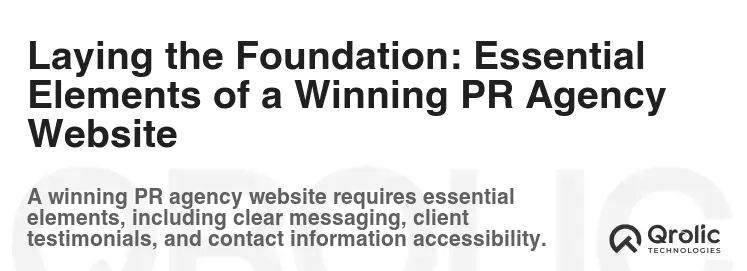
Before diving into design and development, you need a solid plan. Consider these crucial elements:
1. Defining Your Target Audience: Know Your Client
Who are you trying to reach? Large corporations? Small businesses? Non-profit organizations? Understanding your target audience informs every aspect of your website, from design and content to calls to action. This process directly impacts your public relations web design decisions.
- Create Buyer Personas: Develop detailed profiles of your ideal clients, including their demographics, needs, pain points, and online behavior.
- Analyze Competitor Websites: Identify what works well (and what doesn’t) on your competitors’ websites.
- Gather Client Feedback: Survey existing clients to understand their needs and expectations.
2. Setting Clear Goals: What Do You Want Your Website to Achieve?
Define specific, measurable, achievable, relevant, and time-bound (SMART) goals for your website. Examples include:
- Increase lead generation by X% in Y months.
- Generate Z qualified leads per month.
- Improve website traffic by W% in V months.
- Increase brand awareness by N% based on social media engagement.
3. Information Architecture: Structuring Your Content for Success
Plan the organization and structure of your website content. This includes creating a sitemap that outlines all the pages and their relationships.
- Prioritize User Experience (UX): Design your website with the user in mind, ensuring easy navigation and intuitive information architecture.
- Keep it Simple: Avoid clutter and unnecessary complexity. A clean, well-organized website is more effective.
- Use Clear and Concise Language: Avoid jargon and technical terms that your target audience may not understand.
4. Content Strategy: Fueling Your Website with Value
Develop a content strategy that aligns with your target audience and business goals. This includes planning the types of content you will create (blog posts, case studies, videos, etc.), as well as the topics you will cover.
- Focus on Quality over Quantity: Create high-quality, informative content that provides value to your target audience.
- Optimize for Search Engines: Use relevant keywords throughout your content to improve your website’s search engine ranking. Focusing on keywords such as PR agency website development, public relations web design, and media relations website is critical.
- Maintain a Consistent Brand Voice: Ensure that all of your content reflects your agency’s brand personality and values.
- Include Variety: Mix up the type of content you publish to keep your audience engaged.
- Update Regularly: Keep your website fresh and relevant by regularly publishing new content.
Designing for Impact: Visual Appeal and User Experience in PR Web Design
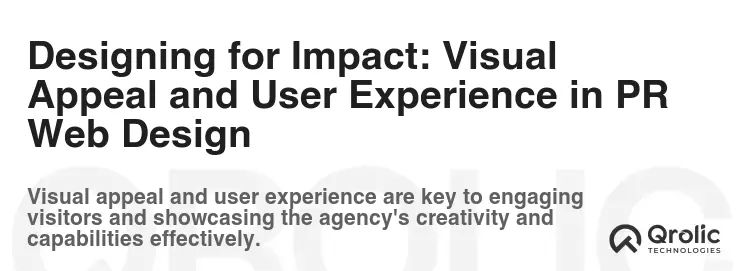
Your website’s design is crucial for creating a positive first impression and engaging your target audience.
1. Visual Branding: Reflecting Your Agency’s Identity
- Logo and Color Palette: Use your agency’s logo and color palette consistently throughout the website.
- Typography: Choose fonts that are easy to read and reflect your brand personality.
- Imagery: Use high-quality images and videos that are relevant to your content.
- Overall Aesthetic: Create a visually appealing design that is consistent with your brand identity.
2. User-Friendly Navigation: Guiding Visitors Seamlessly
- Clear and Concise Menu: Make it easy for visitors to find what they are looking for with a clear and concise menu.
- Intuitive Navigation: Use intuitive navigation that makes it easy for visitors to browse your website.
- Search Functionality: Provide a search function that allows visitors to quickly find specific information.
- Mobile-Friendly Design: Ensure that your website is responsive and looks great on all devices.
3. Calls to Action (CTAs): Driving Conversions
- Strategic Placement: Place CTAs strategically throughout your website to encourage visitors to take action.
- Compelling Language: Use compelling language that motivates visitors to click.
- Clear and Concise Messaging: Make it clear what you want visitors to do.
- Visually Appealing Design: Design your CTAs to be visually appealing and stand out from the rest of the page.
4. Mobile Responsiveness: Adapting to Every Screen
In today’s mobile-first world, a responsive website is non-negotiable.
- Test on Different Devices: Ensure that your website looks and functions properly on all devices.
- Optimize for Mobile Performance: Optimize your website for mobile performance by reducing image sizes and using a mobile-friendly design.
- Prioritize Mobile Users: Design your website with mobile users in mind, ensuring a seamless experience on smartphones and tablets.
Technical Mastery: Development and Optimization for Peak Performance
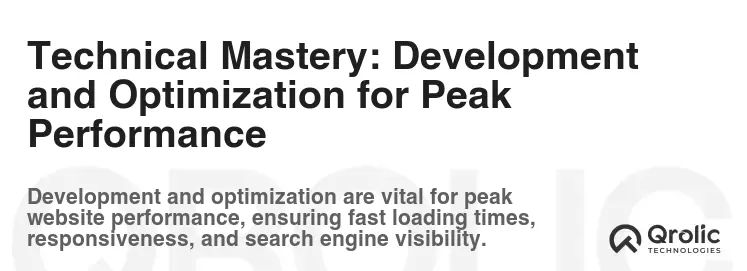
The technical aspects of your website are just as important as the design and content.
1. Choosing the Right Platform: CMS Selection (WordPress, Drupal, etc.)
Select a content management system (CMS) that meets your needs and technical capabilities. WordPress is a popular choice, offering flexibility and a wide range of plugins.
- Consider Your Technical Skills: Choose a CMS that you are comfortable using and managing.
- Evaluate Features and Functionality: Select a CMS that offers the features and functionality you need.
- Research Security and Support: Ensure that the CMS you choose is secure and well-supported.
- Think About Scalability: Choose a CMS that can scale as your business grows.
2. Optimizing for Speed: Page Load Time is Critical
Website Speed is a crucial factor in user experience and search engine ranking.
- Optimize Images: Compress images to reduce file size without sacrificing quality.
- Minimize HTTP Requests: Reduce the number of HTTP requests by combining files and using a content delivery network (CDN).
- Leverage Browser Caching: Enable browser caching to store frequently accessed resources locally.
- Choose a Fast Hosting Provider: Select a hosting provider that offers fast and reliable performance.
3. Implementing SEO Best Practices: Making Your Website Discoverable
Search engine optimization (SEO) is essential for driving organic traffic to your website.
- Keyword Research: Conduct keyword research to identify the terms that your target audience is searching for. Target keywords like PR agency website development, public relations web design, and media relations website.
- On-Page Optimization: Optimize your website’s content and structure for search engines.
- Off-Page Optimization: Build high-quality backlinks from other websites to improve your website’s authority.
- Technical SEO: Ensure that your website is technically sound and easily crawlable by search engines.
- Monitor and Analyze: Track your website’s SEO performance and make adjustments as needed.
4. Security Measures: Protecting Your Website and Data
Protect your website from security threats by implementing robust security measures.
- Use a Secure Hosting Provider: Choose a hosting provider that offers secure hosting and regular security updates.
- Install a Security Plugin: Install a security plugin to protect your website from malware and other threats.
- Use Strong Passwords: Use strong passwords for all of your website accounts.
- Keep Your Software Up-to-Date: Keep your CMS, plugins, and themes up-to-date to patch security vulnerabilities.
- Regularly Back Up Your Website: Regularly back up your website to protect your data in case of a security breach.
Content is King (and Queen!): Creating Engaging and Valuable Content
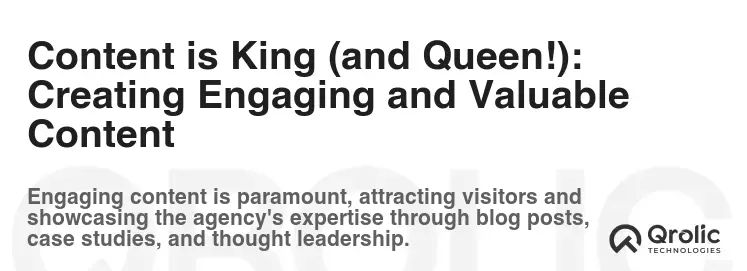
High-quality content is the foundation of a successful PR agency website.
1. Blog Posts: Sharing Insights and Expertise
- Industry Trends: Write about the latest trends in the PR industry.
- Tips and Advice: Share tips and advice on topics related to PR, media relations website development, and marketing.
- Case Studies: Showcase your successful campaigns with detailed case studies.
- Thought Leadership: Share your unique perspectives on industry issues.
- Behind-the-Scenes: Give your audience a glimpse into your agency’s culture and operations.
2. Case Studies: Demonstrating Your Successes
- Highlight Results: Focus on the results you achieved for your clients.
- Tell a Story: Tell a compelling story about the challenges you faced and how you overcame them.
- Use Data and Metrics: Back up your claims with data and metrics.
- Include Client Testimonials: Feature client testimonials to add credibility to your case studies.
3. Videos: Engaging Your Audience Visually
- Agency Overview: Create a video that introduces your agency and its services.
- Client Testimonials: Feature client testimonials in video format.
- Behind-the-Scenes: Give your audience a behind-the-scenes look at your agency.
- Educational Content: Create videos that educate your audience on PR and marketing topics.
4. Infographics: Visualizing Data and Information
- Present Data in a Visually Appealing Way: Use infographics to present data and information in a visually appealing way.
- Make Complex Information Easy to Understand: Simplify complex information with infographics.
- Shareable Content: Create infographics that are easy to share on social media.
The Power of a Portfolio: Showcasing Your Best Work

Your portfolio is your opportunity to demonstrate your skills and experience to potential clients.
1. Highlighting Successful Campaigns: Showcasing Your Achievements
- Focus on Results: Showcase the results you achieved for your clients.
- Include Detailed Descriptions: Provide detailed descriptions of your campaigns, including the goals, strategies, and tactics you used.
- Use Visuals: Include visuals such as images and videos to showcase your work.
- Feature Client Testimonials: Feature client testimonials to add credibility to your portfolio.
2. Organizing Your Portfolio: Making it Easy to Browse
- Categorize Your Work: Categorize your work by industry, service, or campaign type.
- Use Filters: Allow visitors to filter your portfolio by category or keyword.
- Provide a Search Function: Provide a search function that allows visitors to quickly find specific projects.
3. Maintaining an Up-to-Date Portfolio: Keeping it Fresh and Relevant
- Regularly Update Your Portfolio: Regularly update your portfolio with your latest work.
- Remove Outdated Projects: Remove outdated projects that no longer reflect your current skills and capabilities.
- Ensure Accuracy: Ensure that all information in your portfolio is accurate and up-to-date.
Measuring Success: Analytics and Reporting
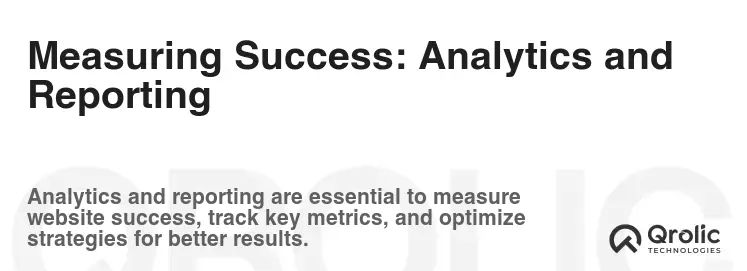
Track your website’s performance to identify areas for improvement.
1. Setting Up Google Analytics: Tracking Key Metrics
- Website Traffic: Track the number of visitors to your website.
- Bounce Rate: Measure the percentage of visitors who leave your website after viewing only one page.
- Time on Site: Track the average amount of time that visitors spend on your website.
- Conversion Rate: Measure the percentage of visitors who take a desired action, such as filling out a form or contacting you.
- Goal Tracking: Set up goal tracking to measure the success of your website in achieving its objectives.
2. Analyzing Data and Identifying Areas for Improvement
- Identify Trends: Identify trends in your website’s performance.
- Pinpoint Areas of Weakness: Pinpoint areas of weakness in your website’s performance.
- Develop Actionable Insights: Develop actionable insights based on your data analysis.
3. Reporting and Communication: Sharing Insights with Your Team
- Create Regular Reports: Create regular reports on your website’s performance.
- Share Insights with Your Team: Share your insights with your team and stakeholders.
- Use Data to Inform Decision-Making: Use data to inform decision-making and prioritize improvement efforts.
Ongoing Maintenance: Keeping Your Website Fresh and Secure

Your website is not a “set it and forget it” project. Ongoing maintenance is essential for keeping it fresh, secure, and performing at its best.
1. Regular Updates: CMS, Plugins, and Themes
- Stay Up-to-Date: Keep your CMS, plugins, and themes up-to-date to patch security vulnerabilities and ensure compatibility.
- Test Updates Before Implementing: Test updates on a staging environment before implementing them on your live website.
- Backup Your Website Before Updating: Backup your website before updating to protect your data in case of an issue.
2. Security Monitoring: Protecting Against Threats
- Regularly Scan for Malware: Regularly scan your website for malware and other security threats.
- Monitor for Suspicious Activity: Monitor your website for suspicious activity, such as unauthorized logins or file modifications.
- Implement Security Measures: Implement security measures to protect your website from attacks.
3. Content Refresh: Keeping Your Content Relevant
- Review Your Content Regularly: Review your website’s content regularly to ensure that it is accurate, up-to-date, and relevant.
- Update Outdated Content: Update outdated content to reflect current information and trends.
- Add New Content: Add new content to keep your website fresh and engaging.
4. Performance Optimization: Ensuring Speed and Reliability
- Regularly Test Your Website’s Speed: Regularly test your website’s speed to identify areas for improvement.
- Optimize Images: Optimize images to reduce file size and improve page load time.
- Minimize HTTP Requests: Minimize HTTP requests by combining files and using a content delivery network (CDN).
- Leverage Browser Caching: Enable browser caching to store frequently accessed resources locally.
Qrolic Technologies: Your Partner in PR Agency Website Development
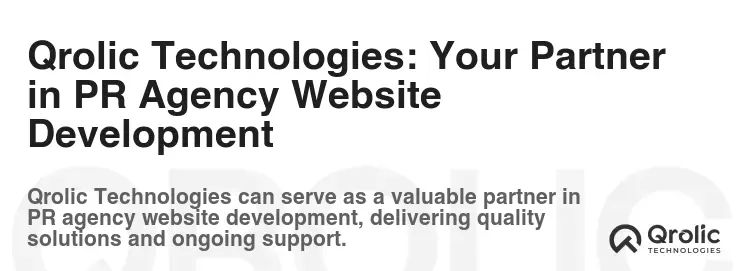
Qrolic Technologies (https://qrolic.com/) is a leading provider of website development services, specializing in creating high-performance websites for PR agencies. We understand the unique needs of the PR industry and are committed to delivering solutions that help our clients achieve their business goals. We build great media relations website according to your requirements.
Why Choose Qrolic Technologies?
- Expertise in PR Agency Website Development: We have extensive experience in developing websites for PR agencies, understanding the specific requirements and challenges of the industry.
- Customized Solutions: We offer customized website development solutions that are tailored to your unique needs and business goals.
- Focus on User Experience: We prioritize user experience, ensuring that your website is easy to navigate and engaging for your target audience.
- SEO Optimization: We implement SEO best practices to ensure that your website is easily discoverable by search engines.
- Mobile-First Approach: We design websites with a mobile-first approach, ensuring that your website looks and functions perfectly on all devices.
- Ongoing Support and Maintenance: We provide ongoing support and maintenance to keep your website fresh, secure, and performing at its best.
- Proven Track Record: We have a proven track record of delivering successful website development projects for PR agencies of all sizes.
Our Services
- Website Design and Development: We offer comprehensive website design and development services, from initial concept to launch.
- Content Management System (CMS) Implementation: We can help you choose and implement the right CMS for your needs, such as WordPress.
- SEO Optimization: We offer SEO optimization services to improve your website’s search engine ranking.
- Mobile Optimization: We optimize your website for mobile devices, ensuring a seamless user experience.
- Website Maintenance and Support: We provide ongoing website maintenance and support to keep your website running smoothly.
- E-commerce Solutions: If you need to sell products or services online, we can develop an e-commerce solution for your website.
Let’s Discuss Your Project
Contact Qrolic Technologies today to discuss your PR agency website development project. We’ll work with you to create a website that reflects your brand, showcases your expertise, and helps you achieve your business goals. Get a free consultation today.
Future Trends: What’s Next for PR Agency Websites?
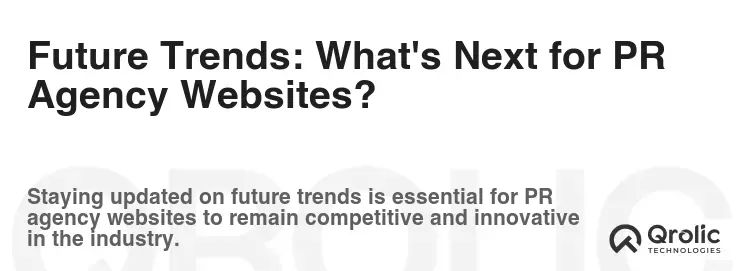
The digital landscape is constantly evolving, and PR agencies need to stay ahead of the curve.
1. Artificial Intelligence (AI) and Chatbots: Enhancing User Experience
- Personalized Content: AI can be used to personalize website content based on user behavior and preferences.
- Chatbots for Customer Support: Chatbots can provide instant customer support and answer common questions.
- Automated Content Creation: AI can be used to automate the creation of certain types of content, such as blog posts and social media updates.
2. Voice Search Optimization: Adapting to How People Search
- Optimize for Conversational Keywords: Optimize your website’s content for conversational keywords that people use when speaking.
- Use Schema Markup: Use schema markup to help search engines understand the context of your content.
- Create Content That Answers Common Questions: Create content that answers common questions that people ask using voice search.
3. Interactive Content: Engaging Visitors in New Ways
- Quizzes and Polls: Use quizzes and polls to engage visitors and gather data.
- Interactive Infographics: Create interactive infographics that allow users to explore data and information in a more engaging way.
- 360-Degree Videos: Use 360-degree videos to give visitors a virtual tour of your agency or showcase your work.
4. Accessibility: Ensuring Your Website is Usable by Everyone
- Follow WCAG Guidelines: Follow the Web Content Accessibility Guidelines (WCAG) to ensure that your website is accessible to people with disabilities.
- Use Alt Text for Images: Use alt text for all images to provide descriptions for visually impaired users.
- Provide Captions for Videos: Provide captions for all videos to make them accessible to hearing-impaired users.
- Use Clear and Concise Language: Use clear and concise language that is easy for everyone to understand.
By embracing these future trends, PR agencies can ensure that their websites remain relevant, engaging, and effective in the ever-changing digital landscape. Focusing on public relations web design that incorporates these trends will be crucial for success.
